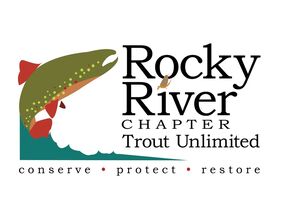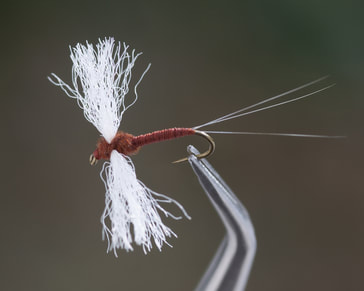Rusty Spinner
Fly of the Month 11.14
The mayfly is an aquatic insect that has been studied by anglers for centuries. The classic imitations are the dry fly which represents the adult, imago or dun stage of the insects life cycle and the wet fly which represents the rising, shucking nymph emerger. These imitations have the longest, well proven history of use by anglers beginning in England and now throughout the world where year-round cold water exists and trout thrive. A more recent stage of the mayfly has a good deal of historical use, the nymph stage which is found on the stream bottom or in the water column drifting free with the current. However, there is a less known but sometimes very important stage to imitate, the spent stage.
Rusty Spinner
The Rusty spinner is named due to the rusty colored body used to tie the fly pattern. As it turns out, the spent mayfly of a number of species turns a rusty color regardless of the original body color. Thus, the Rusty Spinner imitates a number of mayfly species. For example, the spinner fall that I have fished the most is the Sulphur spinner fall on the South Holston River Tailrace in the upper 2 miles below the weir. The spinners are a very dull yellow to rusty brown. A dull yellow spinner will work equally well as a rusty spinner fly pattern. The abundant Blue Wing Olive (BWO) spinner fall is a dull olive to rusty brown as well. I have not fished that spinner fall as it mostly occurs sparsely during the afternoons on overcast, almost drizzly days when nymphing is more successful.
The key to imitating the spent stage of a mayfly is to tie a fly pattern that lies well in the surface film, not rising above the film much and not sinking below the film much. The spent wings are tied perpendicular to the body and flat as possible. Wings of any thickness are not desirable. Sparseness does not necessarily allow for a good flat float so some spinner fly patterns are tied with a double or even a triple spent wing.
The tail of most spinner patterns are split or tied sparsely as three much like the adult mayfly. Hackle is tied around the spent wings but clipped on top and bottom to allow the fly pattern to float flat in the surface film.
RUSTY SPINNER
HOOK : Standard Dry Fly – Tiemco 100 or equivalent. Sizes : 24,22,20,18,16
Thread : UTC 70, rusty brown
Tail : Micro fibetts
Abdomen : Tying thread
Thorax : Rusty Spinner dry fly dubbing
Hackle : Ginger Rooster
Wing : Poly Yarn, dry , white
Directions :
Fly of the Month 11.14
The mayfly is an aquatic insect that has been studied by anglers for centuries. The classic imitations are the dry fly which represents the adult, imago or dun stage of the insects life cycle and the wet fly which represents the rising, shucking nymph emerger. These imitations have the longest, well proven history of use by anglers beginning in England and now throughout the world where year-round cold water exists and trout thrive. A more recent stage of the mayfly has a good deal of historical use, the nymph stage which is found on the stream bottom or in the water column drifting free with the current. However, there is a less known but sometimes very important stage to imitate, the spent stage.
Rusty Spinner
The Rusty spinner is named due to the rusty colored body used to tie the fly pattern. As it turns out, the spent mayfly of a number of species turns a rusty color regardless of the original body color. Thus, the Rusty Spinner imitates a number of mayfly species. For example, the spinner fall that I have fished the most is the Sulphur spinner fall on the South Holston River Tailrace in the upper 2 miles below the weir. The spinners are a very dull yellow to rusty brown. A dull yellow spinner will work equally well as a rusty spinner fly pattern. The abundant Blue Wing Olive (BWO) spinner fall is a dull olive to rusty brown as well. I have not fished that spinner fall as it mostly occurs sparsely during the afternoons on overcast, almost drizzly days when nymphing is more successful.
The key to imitating the spent stage of a mayfly is to tie a fly pattern that lies well in the surface film, not rising above the film much and not sinking below the film much. The spent wings are tied perpendicular to the body and flat as possible. Wings of any thickness are not desirable. Sparseness does not necessarily allow for a good flat float so some spinner fly patterns are tied with a double or even a triple spent wing.
The tail of most spinner patterns are split or tied sparsely as three much like the adult mayfly. Hackle is tied around the spent wings but clipped on top and bottom to allow the fly pattern to float flat in the surface film.
RUSTY SPINNER
HOOK : Standard Dry Fly – Tiemco 100 or equivalent. Sizes : 24,22,20,18,16
Thread : UTC 70, rusty brown
Tail : Micro fibetts
Abdomen : Tying thread
Thorax : Rusty Spinner dry fly dubbing
Hackle : Ginger Rooster
Wing : Poly Yarn, dry , white
Directions :
- Debarb hook. Tie in thread at hook above the hook point. Let the bobbin hang.
- Choose three micro fibetts for the tail and align the tips. Measure the length of the tail against the hook so that they are slightly longer than the hook shank. Tie in the tail with loose wraps, taking the thread toward the bend and keeping the tail on top of the shank. After reaching the end of the straight section of shank, the tail is tied in and needs to be split into three evenly spaced tails. Use the thread to divide the tail closest to you with one wrap between a tail and the other two. This will make that tail stand at an angle to the shank. Repeat on the other side and advance the thread three or four turns. You can adjust the tails with you fingers or bodkin until they are divided equally
- Wrap the thread forward in tight touching wraps to the thorax. Return the thread back to the tail and forward again to the thorax. This will form the abdomen. At the thorax, let the bobbin hang.
- Select a two inch section of poly yarn and cut from the bundle. This section is too thick for the wings and generally about one third to one half is sufficient. Separate the poly and set aside the extra for later flies. Tie in the poly in the middle of the thorax using an “x” pattern of wraps. The wing should remain flat and at right angles to the hook. Return the thread to the back of the thorax and let the bobbin hang.
- Choose a small length of dub and twist on the thread to form a noodle about two inches long. Begin wrapping the noodle at the back of the thorax and move to in front of the wing and continue wrapping to the back of the thorax again. One wrap, at a minimum, should go over the “x” tie in at the wing. If necessary, add another small noodle of thread to form a proper thorax profile and finish the dubbing wraps at the eye. Whip finish.
- Lift the wings straight up and back toward the tail to establish the proper length. They should be the length of the hook shank. While holding them together, in position over the shank, trim with scissors and the fly is complete.

